Critical Analysis of DATS Case Study: Management and Performance
VerifiedAdded on 2020/07/22
|7
|1375
|42
Report
AI Summary
This report provides a comprehensive analysis of the Drug and Alcohol Treatment Service (DATS) case study, focusing on the implications of a merger and the subsequent implementation of Key Performance Indicators (KPIs) and Payment by Result (PbR) on employee performance and organizational dynamics. The report examines the impact of these changes on staff and explores the conflicts that arose between managers and employees. Drawing on relevant theories from occupational and organizational psychology, including the Hawthorne Effect and Scientific Management, the report evaluates the challenges faced by DATS. Furthermore, it applies Kotter's Change Management Theory to propose recommendations for improving organizational performance, addressing employee concerns, and fostering a more harmonious work environment. The analysis highlights the importance of considering employee perspectives and utilizing effective change management strategies to navigate organizational transitions successfully. The report concludes with actionable recommendations for DATS to enhance employee motivation, improve performance, and mitigate potential conflicts. The document is contributed by a student to be published on the website Desklib, a platform which provides all the necessary AI based study tools for students.
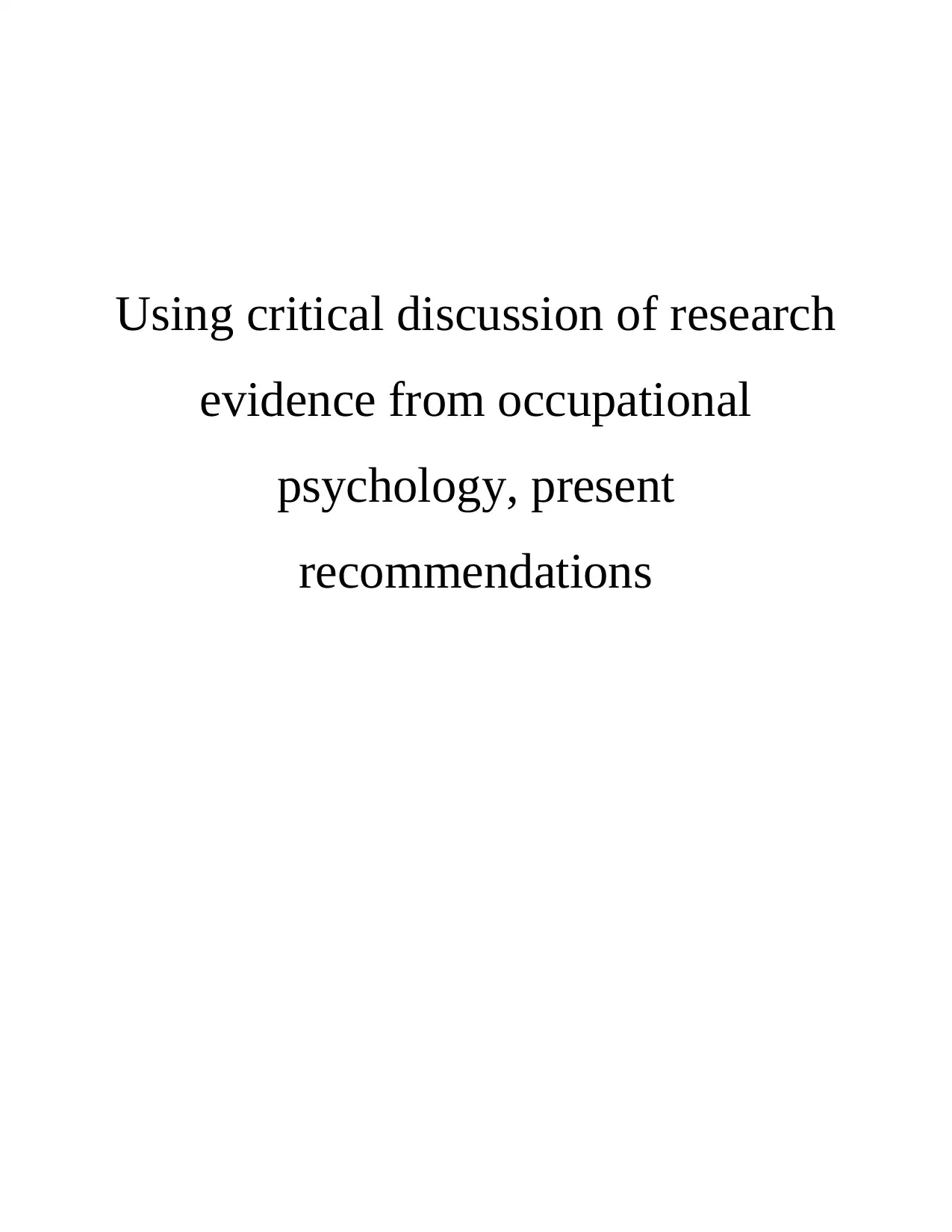
Using critical discussion of research
evidence from occupational
psychology, present
recommendations
evidence from occupational
psychology, present
recommendations
Paraphrase This Document
Need a fresh take? Get an instant paraphrase of this document with our AI Paraphraser
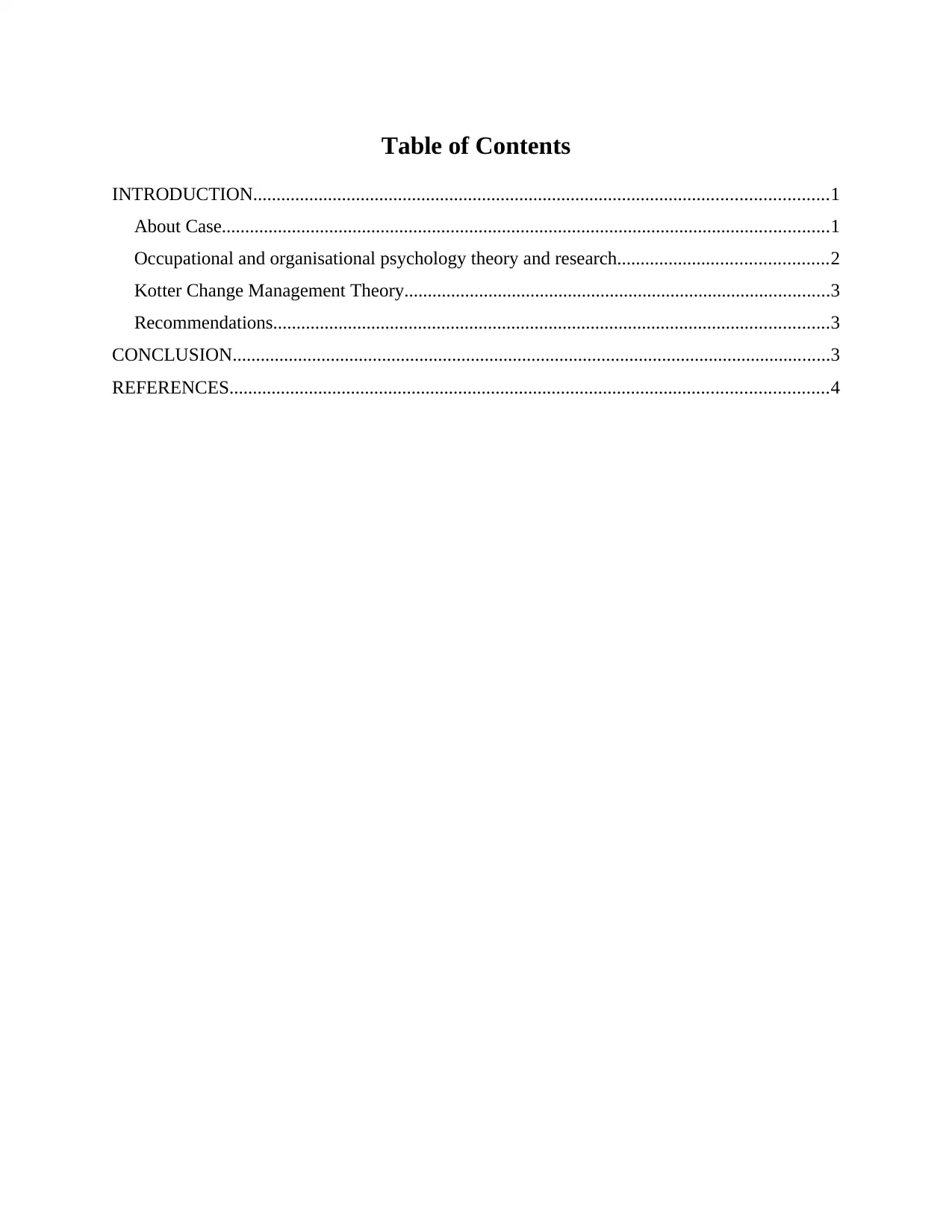
Table of Contents
INTRODUCTION...........................................................................................................................1
About Case..................................................................................................................................1
Occupational and organisational psychology theory and research.............................................2
Kotter Change Management Theory...........................................................................................3
Recommendations.......................................................................................................................3
CONCLUSION................................................................................................................................3
REFERENCES................................................................................................................................4
INTRODUCTION...........................................................................................................................1
About Case..................................................................................................................................1
Occupational and organisational psychology theory and research.............................................2
Kotter Change Management Theory...........................................................................................3
Recommendations.......................................................................................................................3
CONCLUSION................................................................................................................................3
REFERENCES................................................................................................................................4
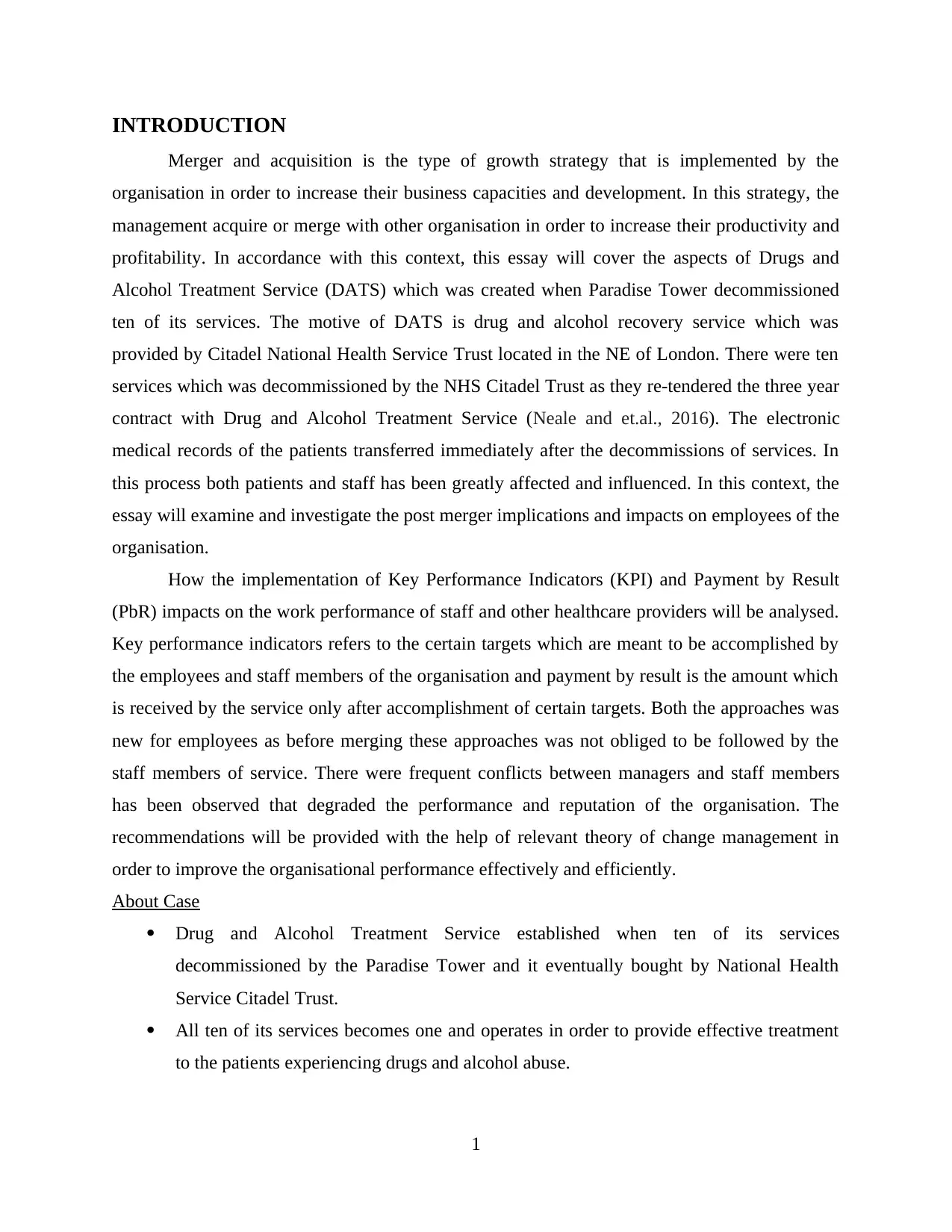
INTRODUCTION
Merger and acquisition is the type of growth strategy that is implemented by the
organisation in order to increase their business capacities and development. In this strategy, the
management acquire or merge with other organisation in order to increase their productivity and
profitability. In accordance with this context, this essay will cover the aspects of Drugs and
Alcohol Treatment Service (DATS) which was created when Paradise Tower decommissioned
ten of its services. The motive of DATS is drug and alcohol recovery service which was
provided by Citadel National Health Service Trust located in the NE of London. There were ten
services which was decommissioned by the NHS Citadel Trust as they re-tendered the three year
contract with Drug and Alcohol Treatment Service (Neale and et.al., 2016). The electronic
medical records of the patients transferred immediately after the decommissions of services. In
this process both patients and staff has been greatly affected and influenced. In this context, the
essay will examine and investigate the post merger implications and impacts on employees of the
organisation.
How the implementation of Key Performance Indicators (KPI) and Payment by Result
(PbR) impacts on the work performance of staff and other healthcare providers will be analysed.
Key performance indicators refers to the certain targets which are meant to be accomplished by
the employees and staff members of the organisation and payment by result is the amount which
is received by the service only after accomplishment of certain targets. Both the approaches was
new for employees as before merging these approaches was not obliged to be followed by the
staff members of service. There were frequent conflicts between managers and staff members
has been observed that degraded the performance and reputation of the organisation. The
recommendations will be provided with the help of relevant theory of change management in
order to improve the organisational performance effectively and efficiently.
About Case
Drug and Alcohol Treatment Service established when ten of its services
decommissioned by the Paradise Tower and it eventually bought by National Health
Service Citadel Trust.
All ten of its services becomes one and operates in order to provide effective treatment
to the patients experiencing drugs and alcohol abuse.
1
Merger and acquisition is the type of growth strategy that is implemented by the
organisation in order to increase their business capacities and development. In this strategy, the
management acquire or merge with other organisation in order to increase their productivity and
profitability. In accordance with this context, this essay will cover the aspects of Drugs and
Alcohol Treatment Service (DATS) which was created when Paradise Tower decommissioned
ten of its services. The motive of DATS is drug and alcohol recovery service which was
provided by Citadel National Health Service Trust located in the NE of London. There were ten
services which was decommissioned by the NHS Citadel Trust as they re-tendered the three year
contract with Drug and Alcohol Treatment Service (Neale and et.al., 2016). The electronic
medical records of the patients transferred immediately after the decommissions of services. In
this process both patients and staff has been greatly affected and influenced. In this context, the
essay will examine and investigate the post merger implications and impacts on employees of the
organisation.
How the implementation of Key Performance Indicators (KPI) and Payment by Result
(PbR) impacts on the work performance of staff and other healthcare providers will be analysed.
Key performance indicators refers to the certain targets which are meant to be accomplished by
the employees and staff members of the organisation and payment by result is the amount which
is received by the service only after accomplishment of certain targets. Both the approaches was
new for employees as before merging these approaches was not obliged to be followed by the
staff members of service. There were frequent conflicts between managers and staff members
has been observed that degraded the performance and reputation of the organisation. The
recommendations will be provided with the help of relevant theory of change management in
order to improve the organisational performance effectively and efficiently.
About Case
Drug and Alcohol Treatment Service established when ten of its services
decommissioned by the Paradise Tower and it eventually bought by National Health
Service Citadel Trust.
All ten of its services becomes one and operates in order to provide effective treatment
to the patients experiencing drugs and alcohol abuse.
1
⊘ This is a preview!⊘
Do you want full access?
Subscribe today to unlock all pages.

Trusted by 1+ million students worldwide
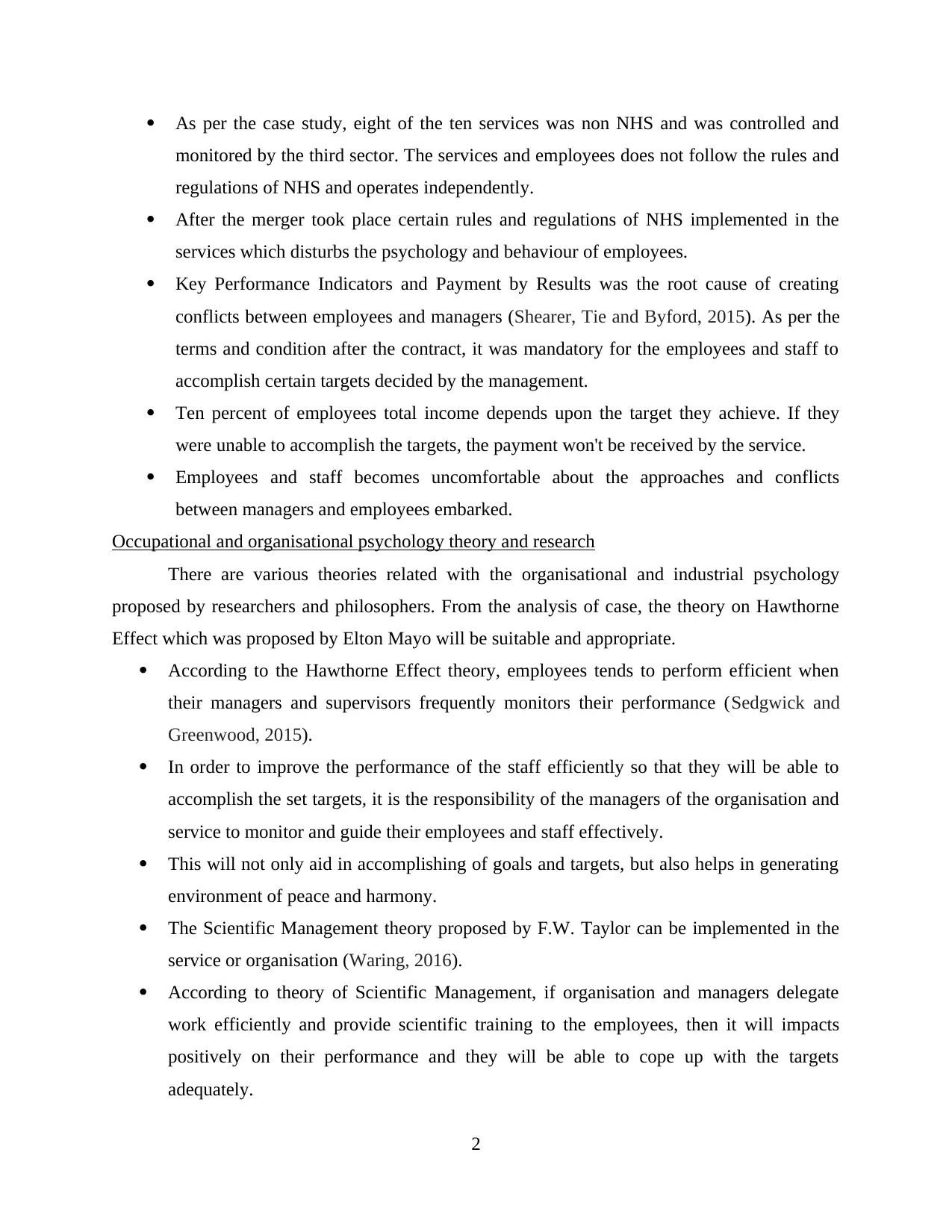
As per the case study, eight of the ten services was non NHS and was controlled and
monitored by the third sector. The services and employees does not follow the rules and
regulations of NHS and operates independently.
After the merger took place certain rules and regulations of NHS implemented in the
services which disturbs the psychology and behaviour of employees.
Key Performance Indicators and Payment by Results was the root cause of creating
conflicts between employees and managers (Shearer, Tie and Byford, 2015). As per the
terms and condition after the contract, it was mandatory for the employees and staff to
accomplish certain targets decided by the management.
Ten percent of employees total income depends upon the target they achieve. If they
were unable to accomplish the targets, the payment won't be received by the service.
Employees and staff becomes uncomfortable about the approaches and conflicts
between managers and employees embarked.
Occupational and organisational psychology theory and research
There are various theories related with the organisational and industrial psychology
proposed by researchers and philosophers. From the analysis of case, the theory on Hawthorne
Effect which was proposed by Elton Mayo will be suitable and appropriate.
According to the Hawthorne Effect theory, employees tends to perform efficient when
their managers and supervisors frequently monitors their performance (Sedgwick and
Greenwood, 2015).
In order to improve the performance of the staff efficiently so that they will be able to
accomplish the set targets, it is the responsibility of the managers of the organisation and
service to monitor and guide their employees and staff effectively.
This will not only aid in accomplishing of goals and targets, but also helps in generating
environment of peace and harmony.
The Scientific Management theory proposed by F.W. Taylor can be implemented in the
service or organisation (Waring, 2016).
According to theory of Scientific Management, if organisation and managers delegate
work efficiently and provide scientific training to the employees, then it will impacts
positively on their performance and they will be able to cope up with the targets
adequately.
2
monitored by the third sector. The services and employees does not follow the rules and
regulations of NHS and operates independently.
After the merger took place certain rules and regulations of NHS implemented in the
services which disturbs the psychology and behaviour of employees.
Key Performance Indicators and Payment by Results was the root cause of creating
conflicts between employees and managers (Shearer, Tie and Byford, 2015). As per the
terms and condition after the contract, it was mandatory for the employees and staff to
accomplish certain targets decided by the management.
Ten percent of employees total income depends upon the target they achieve. If they
were unable to accomplish the targets, the payment won't be received by the service.
Employees and staff becomes uncomfortable about the approaches and conflicts
between managers and employees embarked.
Occupational and organisational psychology theory and research
There are various theories related with the organisational and industrial psychology
proposed by researchers and philosophers. From the analysis of case, the theory on Hawthorne
Effect which was proposed by Elton Mayo will be suitable and appropriate.
According to the Hawthorne Effect theory, employees tends to perform efficient when
their managers and supervisors frequently monitors their performance (Sedgwick and
Greenwood, 2015).
In order to improve the performance of the staff efficiently so that they will be able to
accomplish the set targets, it is the responsibility of the managers of the organisation and
service to monitor and guide their employees and staff effectively.
This will not only aid in accomplishing of goals and targets, but also helps in generating
environment of peace and harmony.
The Scientific Management theory proposed by F.W. Taylor can be implemented in the
service or organisation (Waring, 2016).
According to theory of Scientific Management, if organisation and managers delegate
work efficiently and provide scientific training to the employees, then it will impacts
positively on their performance and they will be able to cope up with the targets
adequately.
2
Paraphrase This Document
Need a fresh take? Get an instant paraphrase of this document with our AI Paraphraser
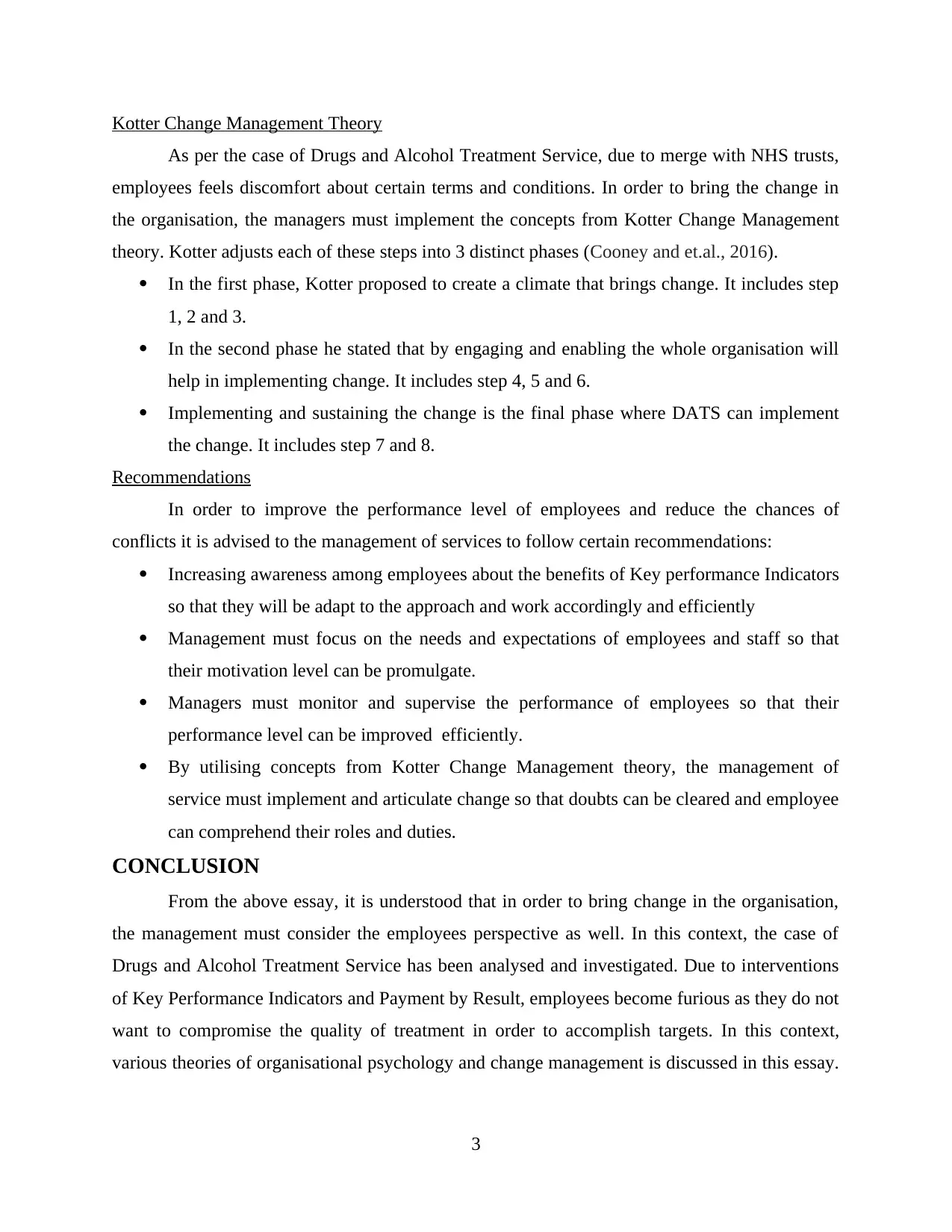
Kotter Change Management Theory
As per the case of Drugs and Alcohol Treatment Service, due to merge with NHS trusts,
employees feels discomfort about certain terms and conditions. In order to bring the change in
the organisation, the managers must implement the concepts from Kotter Change Management
theory. Kotter adjusts each of these steps into 3 distinct phases (Cooney and et.al., 2016).
In the first phase, Kotter proposed to create a climate that brings change. It includes step
1, 2 and 3.
In the second phase he stated that by engaging and enabling the whole organisation will
help in implementing change. It includes step 4, 5 and 6.
Implementing and sustaining the change is the final phase where DATS can implement
the change. It includes step 7 and 8.
Recommendations
In order to improve the performance level of employees and reduce the chances of
conflicts it is advised to the management of services to follow certain recommendations:
Increasing awareness among employees about the benefits of Key performance Indicators
so that they will be adapt to the approach and work accordingly and efficiently
Management must focus on the needs and expectations of employees and staff so that
their motivation level can be promulgate.
Managers must monitor and supervise the performance of employees so that their
performance level can be improved efficiently.
By utilising concepts from Kotter Change Management theory, the management of
service must implement and articulate change so that doubts can be cleared and employee
can comprehend their roles and duties.
CONCLUSION
From the above essay, it is understood that in order to bring change in the organisation,
the management must consider the employees perspective as well. In this context, the case of
Drugs and Alcohol Treatment Service has been analysed and investigated. Due to interventions
of Key Performance Indicators and Payment by Result, employees become furious as they do not
want to compromise the quality of treatment in order to accomplish targets. In this context,
various theories of organisational psychology and change management is discussed in this essay.
3
As per the case of Drugs and Alcohol Treatment Service, due to merge with NHS trusts,
employees feels discomfort about certain terms and conditions. In order to bring the change in
the organisation, the managers must implement the concepts from Kotter Change Management
theory. Kotter adjusts each of these steps into 3 distinct phases (Cooney and et.al., 2016).
In the first phase, Kotter proposed to create a climate that brings change. It includes step
1, 2 and 3.
In the second phase he stated that by engaging and enabling the whole organisation will
help in implementing change. It includes step 4, 5 and 6.
Implementing and sustaining the change is the final phase where DATS can implement
the change. It includes step 7 and 8.
Recommendations
In order to improve the performance level of employees and reduce the chances of
conflicts it is advised to the management of services to follow certain recommendations:
Increasing awareness among employees about the benefits of Key performance Indicators
so that they will be adapt to the approach and work accordingly and efficiently
Management must focus on the needs and expectations of employees and staff so that
their motivation level can be promulgate.
Managers must monitor and supervise the performance of employees so that their
performance level can be improved efficiently.
By utilising concepts from Kotter Change Management theory, the management of
service must implement and articulate change so that doubts can be cleared and employee
can comprehend their roles and duties.
CONCLUSION
From the above essay, it is understood that in order to bring change in the organisation,
the management must consider the employees perspective as well. In this context, the case of
Drugs and Alcohol Treatment Service has been analysed and investigated. Due to interventions
of Key Performance Indicators and Payment by Result, employees become furious as they do not
want to compromise the quality of treatment in order to accomplish targets. In this context,
various theories of organisational psychology and change management is discussed in this essay.
3
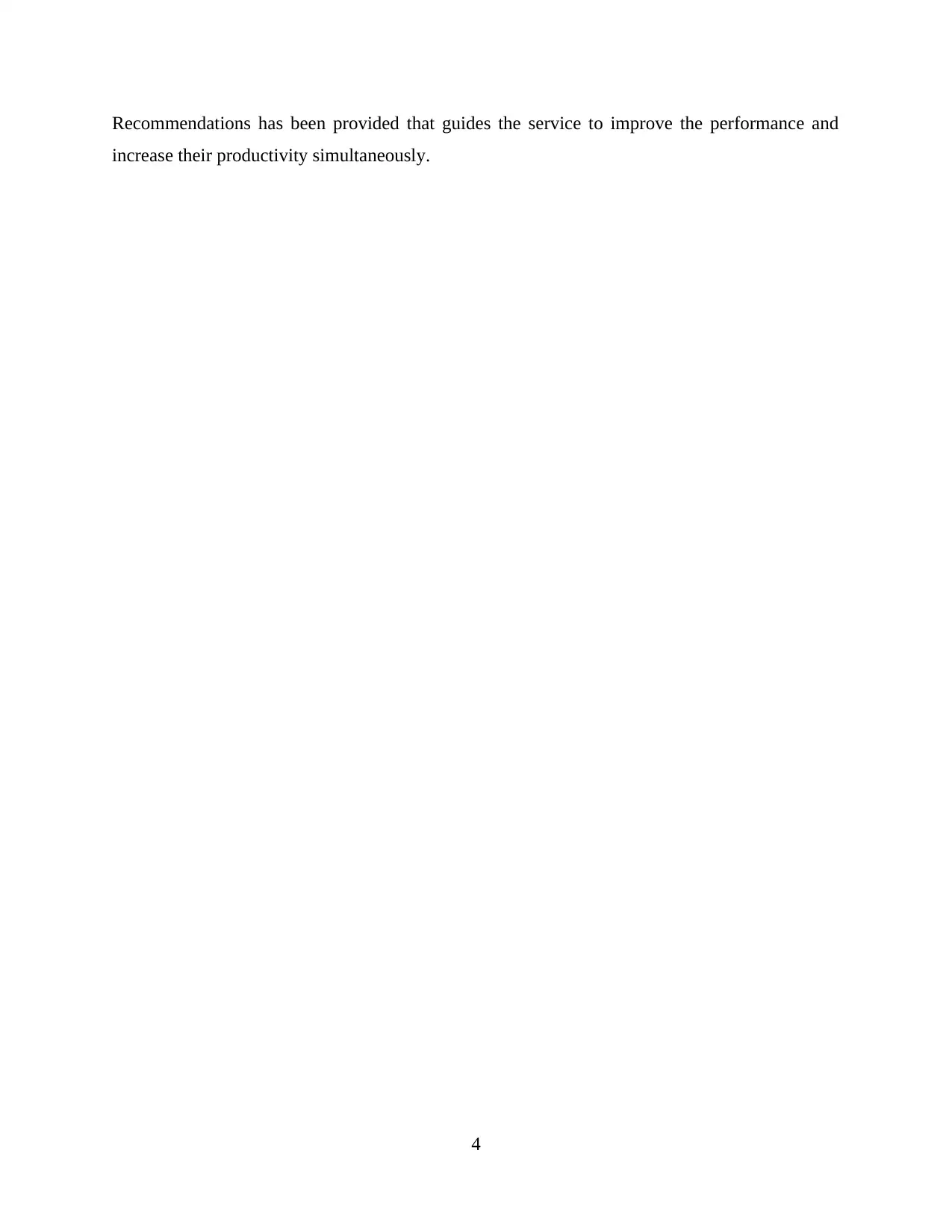
Recommendations has been provided that guides the service to improve the performance and
increase their productivity simultaneously.
4
increase their productivity simultaneously.
4
⊘ This is a preview!⊘
Do you want full access?
Subscribe today to unlock all pages.

Trusted by 1+ million students worldwide
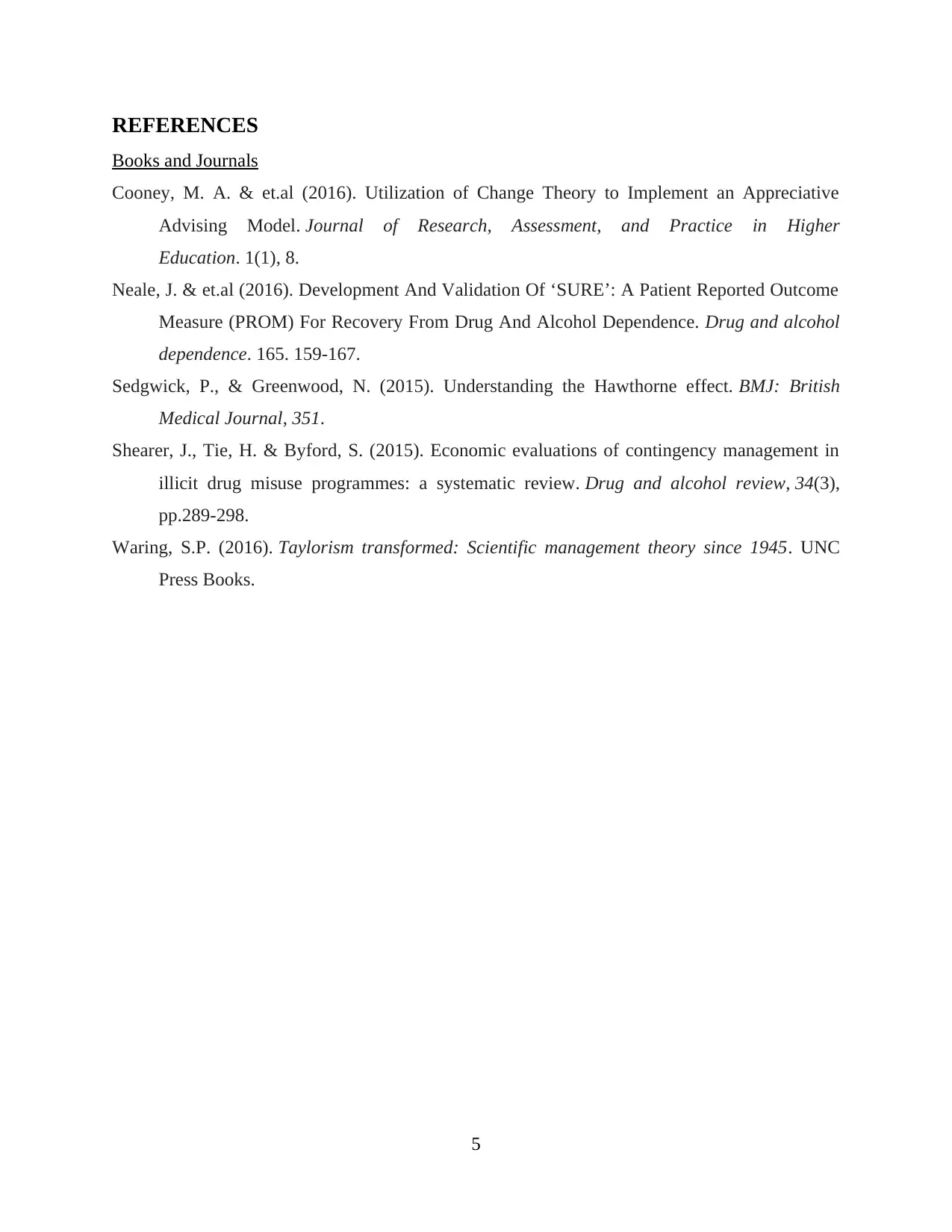
REFERENCES
Books and Journals
Cooney, M. A. & et.al (2016). Utilization of Change Theory to Implement an Appreciative
Advising Model. Journal of Research, Assessment, and Practice in Higher
Education. 1(1), 8.
Neale, J. & et.al (2016). Development And Validation Of ‘SURE’: A Patient Reported Outcome
Measure (PROM) For Recovery From Drug And Alcohol Dependence. Drug and alcohol
dependence. 165. 159-167.
Sedgwick, P., & Greenwood, N. (2015). Understanding the Hawthorne effect. BMJ: British
Medical Journal, 351.
Shearer, J., Tie, H. & Byford, S. (2015). Economic evaluations of contingency management in
illicit drug misuse programmes: a systematic review. Drug and alcohol review, 34(3),
pp.289-298.
Waring, S.P. (2016). Taylorism transformed: Scientific management theory since 1945. UNC
Press Books.
5
Books and Journals
Cooney, M. A. & et.al (2016). Utilization of Change Theory to Implement an Appreciative
Advising Model. Journal of Research, Assessment, and Practice in Higher
Education. 1(1), 8.
Neale, J. & et.al (2016). Development And Validation Of ‘SURE’: A Patient Reported Outcome
Measure (PROM) For Recovery From Drug And Alcohol Dependence. Drug and alcohol
dependence. 165. 159-167.
Sedgwick, P., & Greenwood, N. (2015). Understanding the Hawthorne effect. BMJ: British
Medical Journal, 351.
Shearer, J., Tie, H. & Byford, S. (2015). Economic evaluations of contingency management in
illicit drug misuse programmes: a systematic review. Drug and alcohol review, 34(3),
pp.289-298.
Waring, S.P. (2016). Taylorism transformed: Scientific management theory since 1945. UNC
Press Books.
5
1 out of 7
Your All-in-One AI-Powered Toolkit for Academic Success.
+13062052269
info@desklib.com
Available 24*7 on WhatsApp / Email
![[object Object]](/_next/static/media/star-bottom.7253800d.svg)
Unlock your academic potential
Copyright © 2020–2025 A2Z Services. All Rights Reserved. Developed and managed by ZUCOL.